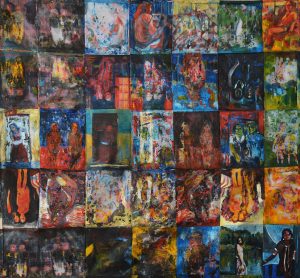Committing to memory, is the act of remembering, or more importantly, refining the memory in both senses of the word: trim, efface and repair . Nevertheless, this effacement and repair, just as it appears from the texture of the images, layers of colorings and brushstrokes, reveals the scars of encountering the dread, those of remembering the cruelty, along with a craving to save love and emotions. The permeation of the color into the silk cloth, through the rhythm of a desiring female body, transforms this remembering into a painful, yet life giving and mending, undergoing.
Committing to memory is a familiar expression. Yet it speaks with a tone that springs to mind another phrase, which happens to be paradoxical: yielding to the mind, burial of the remembrance. Setting it to rest, death, and oblivion. Hence, beyond naming, the emotions that this collection, in its visual texture evokes, reminds me of a proposition by W. J. T Mitchel, which involves in questioning more than what these images merely represent, and towards what do they want.
In Malahat’s paintings, memory is networked through emerging, resolved or tempered faces, relationships flourishing and falling apart within the corridors of the mind and time—engraves a texture of sensation of now, and a vision of future. This possibility comes from the “painterly montage” of the images: from the folding sheets, blurring images, colors infiltrate and diffuse into the texture, fragments of memory colliding and merging into one another. Memories of bygone eras, of which some are vividly remembered, or else, recent ones that are repressed and become irretrievable.
Committing to memory is the syntax of the portraits, figures, hands and their (im)possible gazes; they sometimes fall apart, at times overlap, are dismembered, and by way of ellipsis, fusion, and rearrangement give form to the memory’s depository. Faces that each form a vertebra of the artist’s memory; memories contaminated by pain, ecstasy, joy and fear, in a constant conflict between remembering and active forgetting, amnesia and Tuj (when open wounds start to clot), one by one, colliding and dictating the futures of the artist’s perceptions. The portrait of the father in agony, a lover now part of history, a friend in confinement whose memory scratches upon the mind. Relatives, those who stay, those who vanish. And the one, who observes and experiences, and in the poetics of relations, her body and mind, is grinded and repaired.
The paintings and the way in which they are processed, beg the question as to how many layers of paint, tissues, and dried blood are interwoven when we are getting past by our past. How can one recognize this “I,” in the endless process of transmutation? This me, the mental and material ground upon which these layers are deeply embedded.
Silk, cloth, body and mind; psyche and colors, sensorial tapestries, perceptions; memories and pauses in between. Committing to memory is such a fabric.
Nastaran Saremy
January 2024
About us
Choom Gallery was inaugurated on May 25, 2020, on the occasion of the 100th anniversary of the birth of Jalil Ziapour (1920, Bandar Anzali, 1997, Tehran / Founder of the War Rooster Youth Movement, father of modern painting and creator of art criticism in Iran).
Contact Us
phone: (+98) 013-44549757
mobile: (+98) 9358183252
info@choom.gallery
Hours
Sunday to Friday
4:00pm – 9:00pm
copyright ©2021 all rights reserved for Choom Gallery.
Privacy Policy/ Terms of Use
























